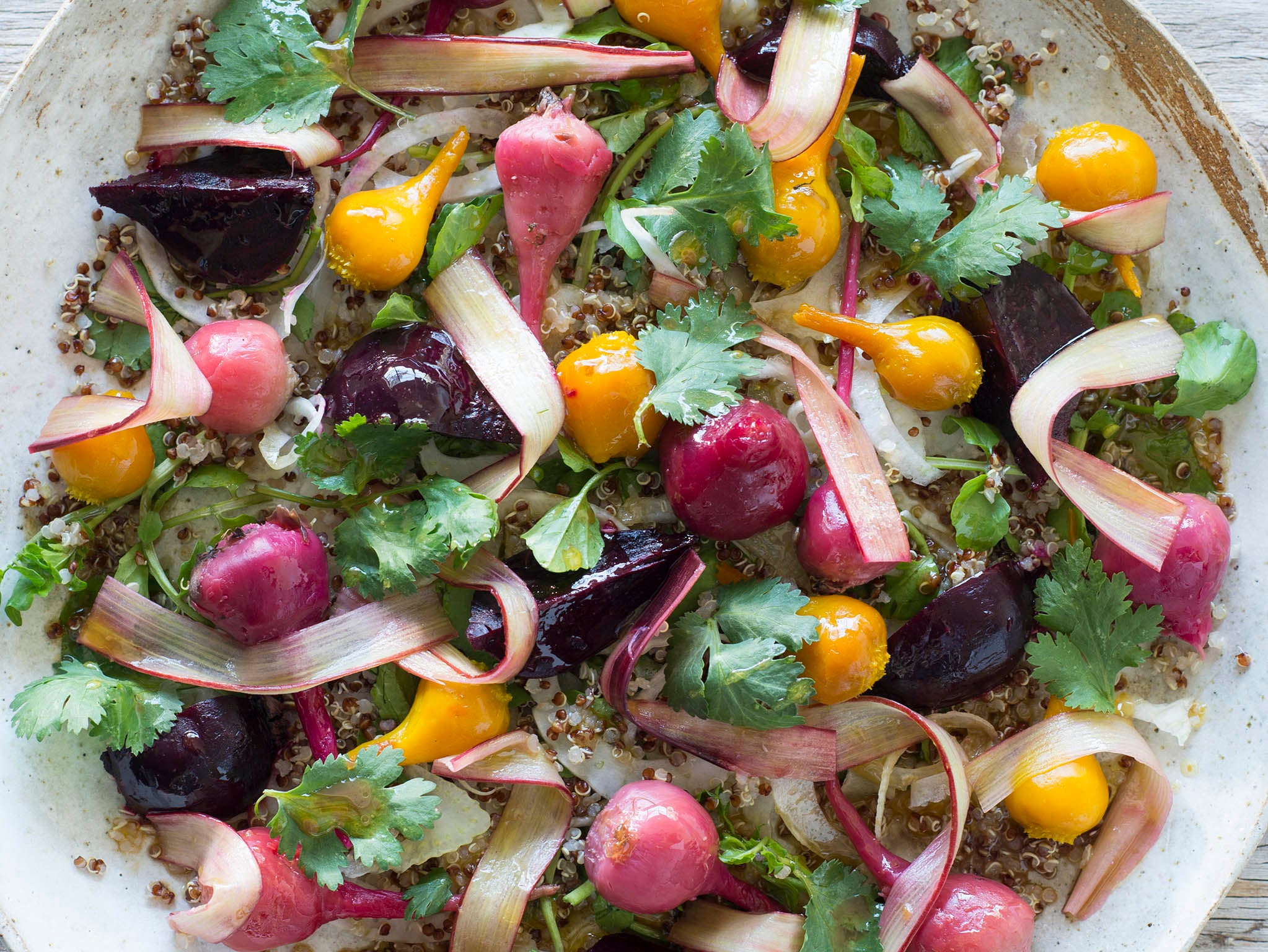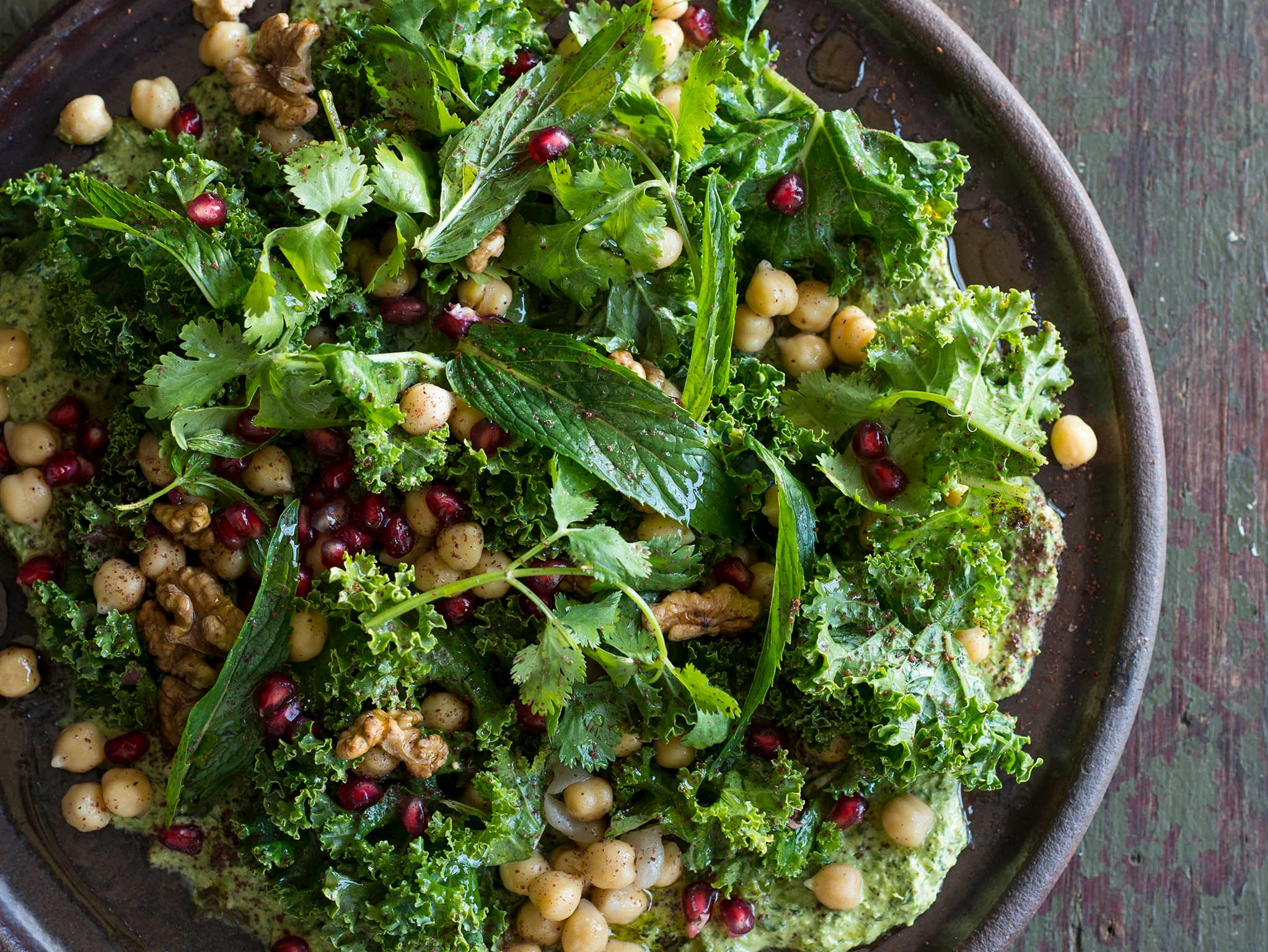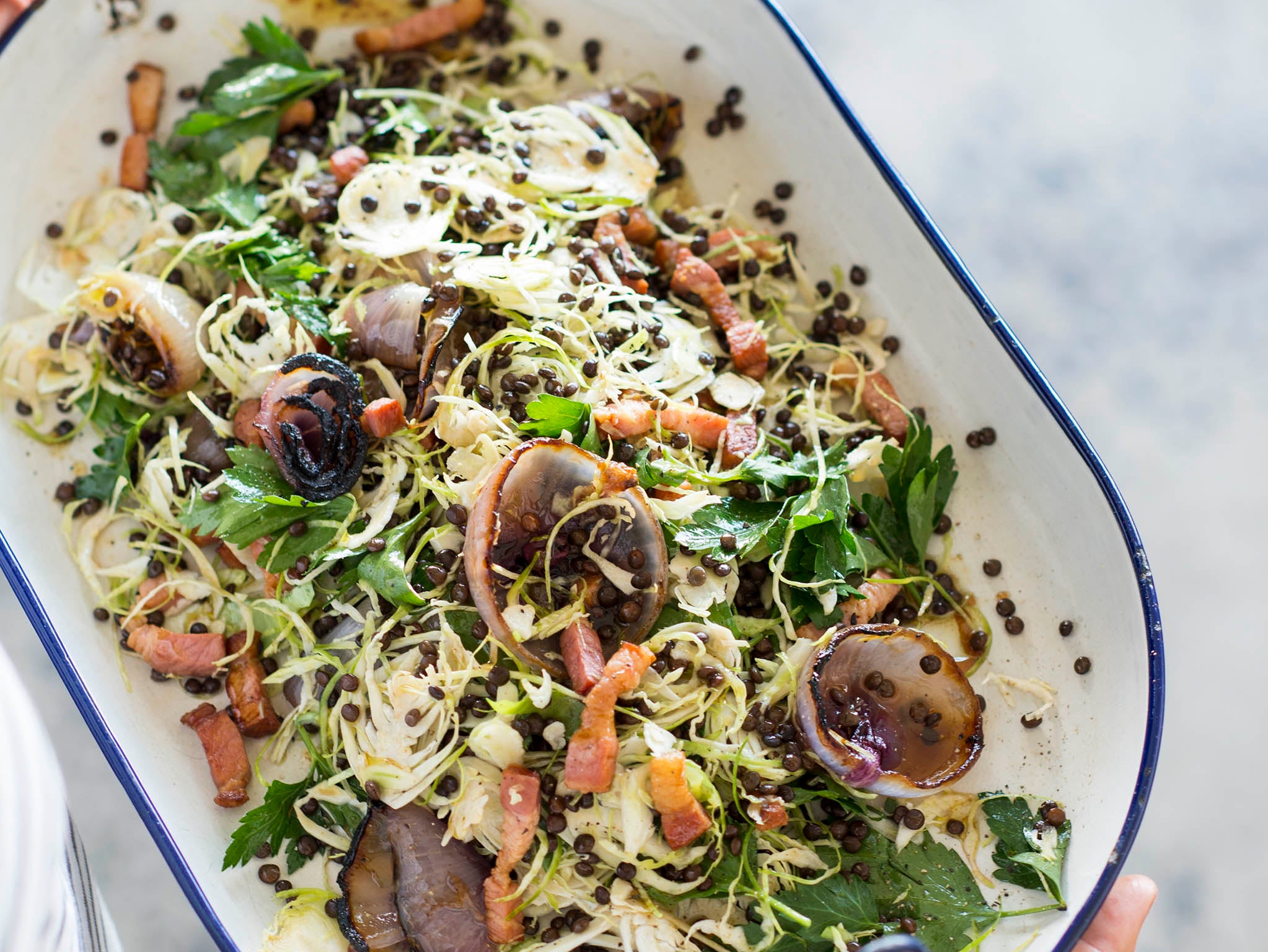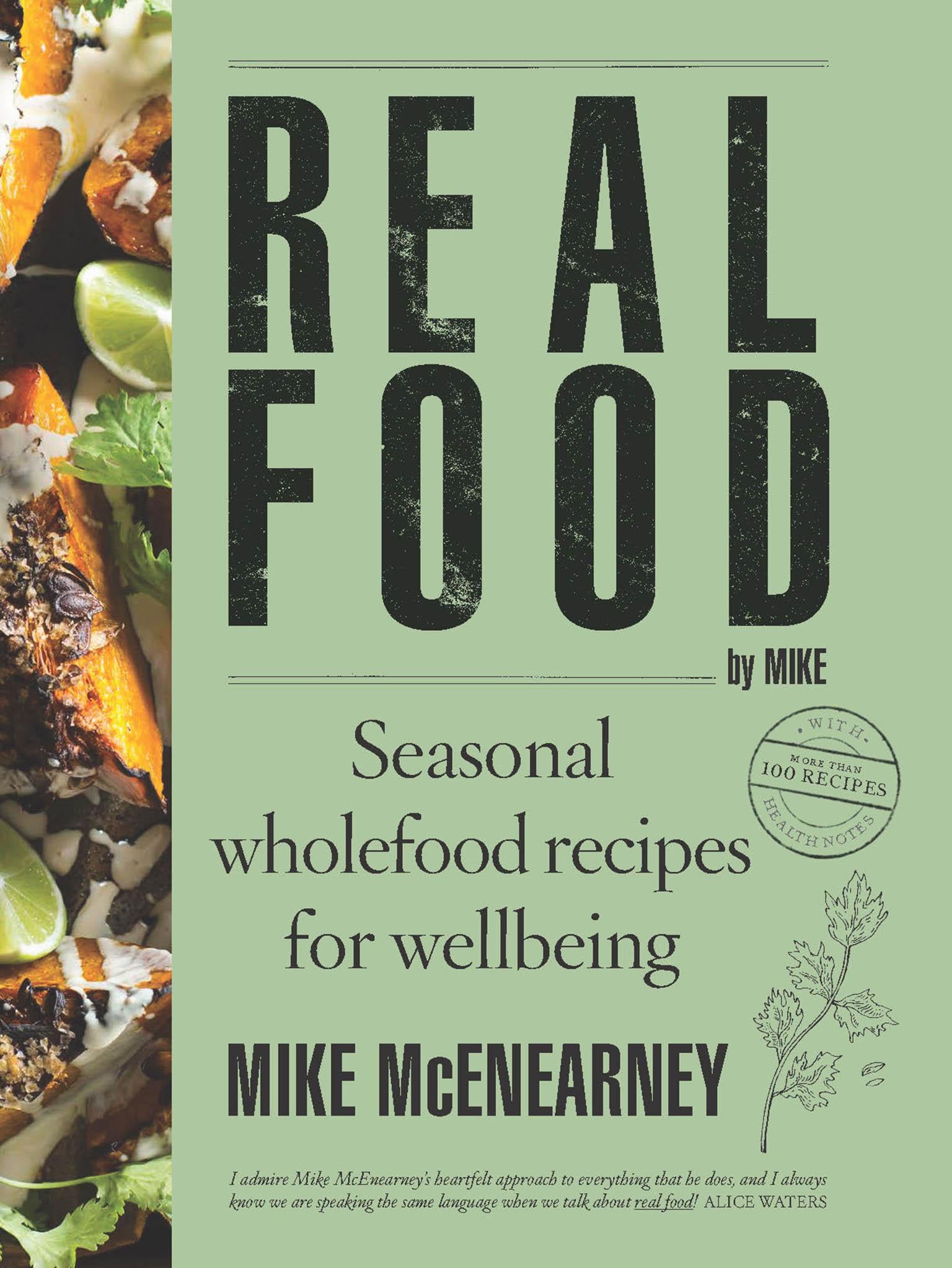Three winter salad recipes from 'Real Food'
We are what we eat, but Mike McEnearney says that doesn't mean what you eat can't be delicious. Try these three winter salads from his new cookbook that are definitely not boring

Beetroot, quinoa, rhubarb and ponzu
Serves 4
170g mixed white and red quinoa, rinsed and soaked
1kg mixed beetroot (beets), such as regular, baby or golden
100ml extra-virgin olive oil
250g rhubarb, sliced very thinly diagonally, using a mandoline
1 pinch sugar
1 fennel bulb, thinly sliced
¼ bunch coriander (cilantro), leaves picked
½ bunch watercress, leaves picked
Yuzu ponzu dressing
125ml Ponzu
25ml yuzu juice (see note)
75ml extra-virgin
olive oil
25ml seasame oil
This salad is so colourful and full of texture. It’s this simple method of cooking beetroot that enables you to keep their integrity and colour and also allows you to peel them after they have been cooked. It’s best to wear a pair of gloves if you don’t want to stain your hands. The rhubarb in this salad adds a lovely tart flavour and is a nice way to serve something in its raw state. The curing from the salt and sugar helps break down the texture.
For the yuzu ponzu dressing, combine all the ingredients in a glass jar and shake well. Set aside. Put the quinoa and 375ml (12½fl oz/1½ cups) of water in a saucepan over a medium-high heat and bring to the boil. When it starts to boil, turn the heat to the lowest setting and place a lid on the pan. Cook for 10 minutes, then turn off the heat, not opening the lid at all during this time. Leave it resting with the lid on for another 10 minutes. Remove the lid, fluff up the quinoa with a fork and leave to cool.
Preheat the oven to 180°C (350°F). Toss the beetroot in the olive oil, season with a little salt and freshly ground black pepper and place them in a roasting tin. Cover the tin tightly with aluminium foil and bake for 30 minutes. Remove the tin from the oven and open the foil. Test the smaller beetroot first to see if they are done – they are cooked when the skin rubs off with your finger. Remove any beetroot that are cooked, cover the tin again with the foil and cook for another 15-20 minutes. Test again and remove the beetroot that are ready. When the beetroot are cool, rub the skin off and cut the beetroot into your desired shapes.
Toss the rhubarb in a bowl with the sugar and a pinch of salt and leave for 10 minutes. Arrange the quinoa, beetroot, fennel and rhubarb on a serving platter and garnish with the coriander and watercress. Pour over the dressing, adjust the seasoning and serve.
Note: Yuzu is a Japanese lime that tastes like a sour mandarin. You can find fresh yuzu or bottled yuzu juice in Asian grocery stores. If you can’t find it, use lime instead.

Salted kale with chickpeas and green tahini
Serves 4
1 generous handful activated walnuts
½ lemon, juiced
1 bunch young kale
200g cooked chickpeas, drained
1 handful coriander (cilantro) leaves
1 handful mint leaves
1 tbsp thinly sliced spring onion (scallion)
1 tbsp each of black and white sesame seeds, toasted seeds from ½ pomegranate
1 tbsp extra-virgin olive oil
½ quantity *green tahini
pinch of sumac, to serve
When making this salad, always look for the youngest kale possible, as old kale is tougher and harder for the body to digest. You can make tougher kale more digestible by sprinkling over some salt and lemon juice or apple-cider vinegar and letting it sit for 15 minutes before eating.
Dehydrate the walnuts until crisp. I’m very lo-fi at home, and we don’t have a dehydrator, so I dehydrate or toast the nuts in the oven at 70°C (160°F) until crisp – usually overnight works best. If you want to season the nuts, simply soak them in salted water so when they dehydrate they have a nice salty bloom on the surface.
Massage the lemon juice and a pinch of salt into the kale, then let it sit for 15 minutes. Remove the kale from the curing bowl and it will be ready to use. Reserve the juice in the bowl. In another bowl, toss all your ingredients together, except the tahini and sumac. Add the juice from the curing bowl for more acidity if needed.
(If you find lemon too sharp, winter is brimming with lovely citrus to choose from, so perhaps try blood orange juice.) Smear the green tahini on a serving platter to make a shallow pool. (I find that if you toss the green tahini through the salad, it is too heavy and will crush your lovely leaves.) Place the dressed ingredients on top, sprinkle with the sumac and serve.
*Green tahini
Makes 250g
225g tahini
1 tbsp crushed garlic
½ tsp sea salt
2 lemons, juiced
10g baby English spinach leaves, chopped
100ml extra-virgin olive oil
½ bunch flat-leaf (Italian) parsley leaves, chopped
½ bunch coriander (cilantro) leaves, chopped
In a food processor, blend the tahini, 125ml (4fl oz/½ cup) of water, the garlic, sea salt, lemon juice and spinach leaves until green and smooth. Blend in the olive oil to emulsify, then fold through the parsley and coriander and pulse to combine. Adjust the salt and lemon juice to taste.
Note: As you can see, this is a dairy-free green tahini. You can omit half the water and add 60 g (2oz) yoghurt instead, for a thicker, richer tahini.

Shredded brussels sprouts, lentils, speck and parsley
Serves 4
2 red onions, unpeeled
60ml extra virgin olive oil, plus extra for drizzling
370g black or green lentils, soaked in water overnight
200g speck, sliced into small batons
1 tbsp sherry vinegar
16 Brussels sprouts
1 lemon
¼ bunch flat-leaf (Italian) parsley, leaves picked, plus extra to serve
It’s a good idea to get into the habit of soaking grains and legumes overnight before you use them. Once soaked, the lentils can be steamed perfectly while keeping them loose and light. Once you’ve cooked them this way, you’ll never go back. Brussels sprouts, being raw cruciferous vegetables, are a lot easier to digest if they have been cured with some sort of acid and salt.
Preheat the oven to 180°C (350°F). Line a baking tray with baking paper. Holding the top and bottom of the onions with your thumb and index finger, cut the onions in half crossways (not from sprout to core). Leaving the skin on, place the onions, cut side down, on the prepared tray. Drizzle with a little extra olive oil and bake for 1 hour, until the onion is extremely soft. Remove the onions from the oven and allow to cool.
Meanwhile, drain the lentils. Place them in a steamer and cook for 25 minutes or until tender. If you don’t have a steamer, cook the lentils in a saucepan of barely simmering water for about 15 minutes until just done. Drain the lentils and separate them with a fork.
Cook the speck slowly in a frying pan over medium–low heat, until it renders down and becomes crispy. Remove the pan from the heat and fold the speck through the lentils, leaving the fat in the pan. For the dressing, add the olive oil and sherry vinegar to the fat in the pan and stir well, scraping any solids from the bottom.

Shred the Brussels sprouts with a mandoline or sharp knife. Put the sprouts in a bowl with a generous pinch of salt and a squeeze of lemon juice. Break down the tough fibres of the sprouts by massaging the salt and lemon juice into them and allowing the sprouts to sit for 15 minutes to cure and soften the leaves. Add the parsley to the bowl, along with the speck and lentils. Spoon in some of the dressing in order to coat the ingredients.
Take the onions and remove the dried skin layer by squeezing the onion gently and pulling up the skin to reveal a glossy, soft inner onion. Pick each layer of onion out and add it to the lentils and Brussels sprouts. Toss together with a little more dressing and serve.
Real Food by Mike: Seasonal Wholefood Recipes for Wellbeing by Mike McEnearney (Hardie Grant, £20)
Join our commenting forum
Join thought-provoking conversations, follow other Independent readers and see their replies
Comments